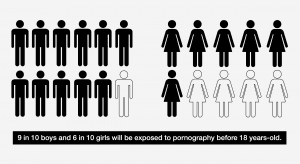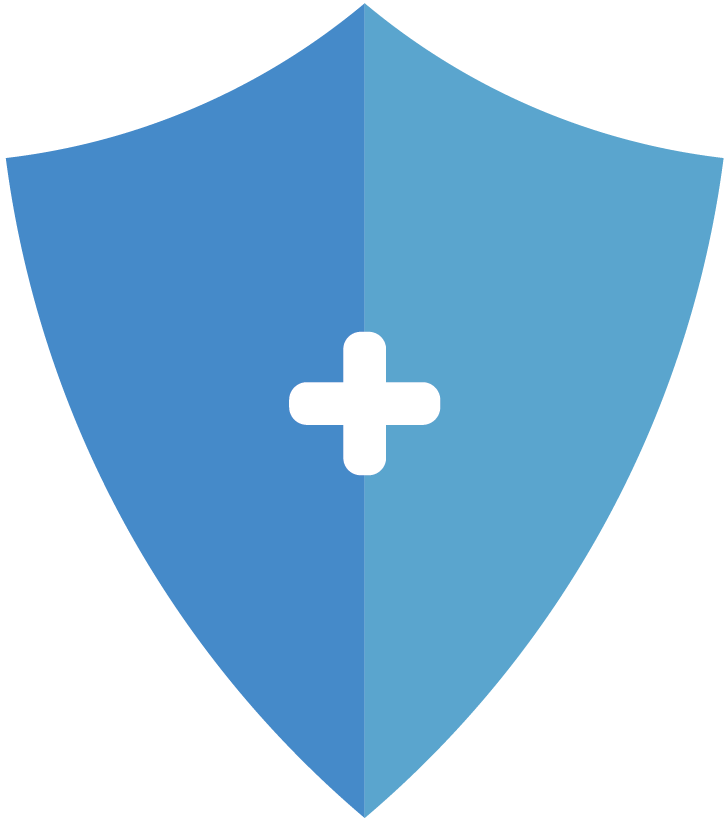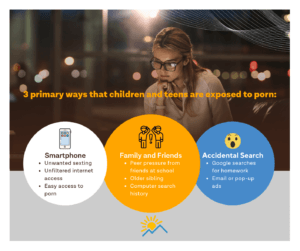Despite many of our popular beliefs, the internet is not a safe place for our children to be roaming around. Pornography and predators seem to be lurking everywhere, just waiting to hook your child into their schemes. It is becoming increasingly important for parents to know the facts about how many teens watch porn, as well as how to approach this topic with them.
In this article we will explore the reality of what children and teens will be introduced to online and the ramifications of that exposure in their lives. We also offer follow-up articles about how to talk to children about porn to help prevent your kids from viewing pornography.
14-Day Free Trial
Protection From Pornography
Change your habits, change your life: Start our 14-day free trial to help get rid of pornography for good.
How many teens are watching porn?
The numbers don’t lie. Your boys have a 90% chance of being exposed to porn before the age of 18, while your girls will have around a 60% chance. Let me rephrase that: 9 in 10 boys and 6 in 10 girls will be exposed to porn before they turn 18 — before they fully mature. Not to mention that one out of every seven teenagers will be subject to online sexual advances.

What’s more, in a study that polled children about pornography exposure before the age of 13, half of the male children and one-third of the female children will have been exposed to pornography in some way.
For the male children, almost a third will be exposed to pornography before they are 10 years old. Perhaps the most troubling part is that the majority of exposure (about two thirds of the group) is unwanted and unwarranted.
If that information does not convince you that internet accountability is crucial for your children, then I don’t know what will.
Where children are being exposed to porn
 3 primary ways that children and teens find and watch pornography:
3 primary ways that children and teens find and watch pornography:
Number 1: Smartphones are how many — if not most — teens watch porn.
Number 2: A child’s first exposure to porn is usually accidental and unwanted.
Number 3: Family members or a child’s friends are a common way that kids find porn.
World-wide more young people than ever before are viewing porn on their smartphones because of unlimited and easy internet access. Even if you install filters and blockers, their friends may not have any safety filters.
Stumbling upon pornography will often occur because of an errant Google search. Errant searches definitely top the list here. Odds are you have done this yourself. You go to Google to search for a person or movie (or almost anything) and start looking through the results to which you find a link to a pornographic video, image, or page.
Another unexpected place where children will often stumble upon pornography is in their email (if they have one). This is pretty common when you think about how much spam email is sent out. Doing a regular safety check on their email is important.
Sexting is becoming more widespread of a problem. Very few teen girls will make it through high-school without being sent or asked for nude photos, according to Nancy Jo Sales, author of American Girls: Social Media and the Secret Lives of Teenagers. Sexting is more serious than they realize, as sending a minor’s nude pictures is still considered illegal child sexual abuse materials (CSAM). It’s important to talk to your teens about sexting and potential consequences.
Unfortunately, if you (or a spouse, child, friend, etc.) have a search history that contains pornographic material, it will make it even easier for your children to have access to pornography when using your device. Even more, if you have downloaded any risqué pornographic content onto your computer, there is a high chance that your kids will find that media. Children are wizards with technology.
Finding your downloaded porn stash or history is obviously is a pretty detrimental to a child. Since they see you as a role model, they will want to emulate your actions. It encourages your child to think it’s normal to watch porn. For more information on how your pornographic consumption affects your child, please read this article.
One very common way children and teens are exposed to porn is through a family member or friend. Usually it’s a pretty simple process. A friend or sibling is exposed to pornography and starts using it. Then, after being found out (or due to a sense of “coolness”) they end up showing your child what they have been looking at.
Just like stumbling across pornography on a loved ones device, this type of interaction provokes a higher interest in pursuing it further. If your child’s friends are all looking at pornography, then there will be a strong pull for them to do the same. They’ll think it’s normal for kids to watch porn. Peer pressure plays a key role in our children’s exposure — and intake — of pornography
How will being exposed to porn affect my child?
If you made it this far, I’m sure you are concerned with how likely it is that your child will view pornography. Some brush this off and say it’s normal for kids to watch porn.
A growing number of adults are concerned about porn’s effects on children. There is still much to be researched on this topic. Some of the results are debatable, but there’s nonetheless a lot of strong anecdotal evidence about negative results.
Neuroplasticity — how porn affects brain development
In order to better explain porn’s effects on children, I want to briefly touch on a concept called neuroplasticity.
Neuroplasticity is the process by which your brain creates new neural networks by constantly reorganizing itself. Basically, this means that your brain is constantly optimizing itself to perform efficiently despite any loss to brain function due to age, injury, etc.
One of the known components of neuroplasticity is that as we age our brains become less plastic, and resist change at a higher degree than when we were younger. Children’s brains are developing rapidly. Neuroplasticity is at its highest during our childhood and adolescent phases. Then it decreases continually for the remainder of our lives.
“Once such a critical period ends, there is a precipitous drop in the
number of connections that are maintained, and the ones that do remain
are the ones that have been strengthened by the appropriate sensory
experiences. This massive “pruning back” of excess synapses often occurs
during adolescence.” — Britannica.com
(Please note that this does not mean that we cannot change our brains, or ways of thinking, once we are older. It just means that our brain cannot restructure itself as easily).
This also means that our children’s brains are literally being shaped by their experiences. As most of us know, those experiences will determine much of their character throughout their lives.

So, due to the high neuroplasticity, any values or ideas that are learned from pornography will have a lasting impact on children’s lives if they are not addressed appropriately.
Like other highly stimulating experiences, porn trains the brain if watched repeatedly. Porn is a super-normal brain stimulus that releases pleasure chemicals in the brain.
During childhood especially, brain connections that are reinforced by stimulus become stronger. Porn is like “crack” for the brain, which is why many teens watch porn regularly.
In addition, habits built during this time become the triggers that drive the continual use of pornography as we age. (For more information on triggers, check out our article about them here).
Along with the habits and triggers that are created from pornography exposure in, research suggests other negative effects also carry over, such as porn withdrawal when/if they decide to quit watching porn. The Association for Pediatrics conducted a study on these effects and found distinct results of children viewing pornography.
Rape culture, teens and porn

Male subjects in particular tended to objectify women. In other words, teen boys who watch porn view women as more of an object than an individual, an attitude linked to current rape theories.
Pornography portrays women (and men) as enjoying degrading and/or violent sexual encounters. This can influence young men to believe women might enjoy being raped–or that they would welcome it. Naturally this could create laissez-faire attitude about rape in general, that it is not a big deal.
Worst case scenario, pornography cultivates a culture of men who do not take rape seriously. These views will often be associated with an interest in more extreme forms of pornography–often more violent. It has been shown that the more pornography is consumed, the more the viewer will begin to desire “novel” forms of pornography.
A casual attitude toward sexual violence against women is directly related to pornography consumption, and people who have trouble quitting porn.
Statistically, 2 out of 3 victims of child sexual abuse are between the ages of 12-17, according to Rape, Abuse, & Incest National Network RAINN, the nation’s largest anti-sexual violence organization.. As a parent, the following statistics from RAINN should concern you even more. Even though rape statistics have fallen, the fact that females 19 and younger are 4 times more likely to be victims of sexual assault is pandemic-level and catastrophic.
- One in 9 girls and 1 in 53 boys under the age of 18 experience sexual abuse or assault at the hands of an adult.
- 82% of all victims under 18 are female.
- Females ages 16-19 are 4 times more likely than the general population to be victims of rape, attempted rape, or sexual assault.“
Devaluing Commitment

For children in general, there is a strong indication that the exposure to pornography results in a hyper-sexual view of the world.
The subjects tended to have a high rate of devaluing marriage; they are twice as likely to believe that marriage is unimportant. One reason researchers give is that children see their parents with multiple sexual partners both in and out of a marriage. Thus children are open to multiple sexual partners before marriage, as well as infidelity in a committed relationship. And why would this come as a surprise?
Pornography commercializes and devalues the role of sex in our culture. When you adopt the view that pornography is normal and acceptable — to have sex with whomever you want, whenever you want — then the ideals of long, committed relationships with a single partner are valued less highly.
More than anything, the pornographic worldview creates a culture of recreational sex. It destroys the basis for intimacy and promotes infidelity for both sexes.
Shameless conversations as a preventative measure
The only way to overcome these effects is to talk with your children about sex, values, and pornography in a healthy way that does not promote shame.
Finding a way to meet your child where they are at, without forcing them into isolation due to shame is hugely important. Offer an “ask me anything you want to know about sex” opportunity.
If anything, isolation and the stigma of talking about sex is what has allowed pornography to flourish. Shaming your child will only reinforce a secretive habit, if they are already watching porn.
It’s also important for them to know that porn portrays sex in a very unrealistic manner, as the New York Times article notes, and it sets false expectations. These expectations hurt future relationships.
14-Day Free Trial
Protection From Pornography
Change your habits, change your life: Start our 14-day free trial to help get rid of pornography for good.


Prevention is the best cure after all. That’s why we so strongly believe in and encourage an open atmosphere of accountability. If you can cultivate this with your children, we believe your hard work will pay off. Even better, your children will reap the benefits of learning to say no to porn.
Sources:
https://psychcentral.com/lib/teens-and-internet-pornography/
http://www.apa.org/monitor/nov07/webporn.aspx
https://www.psychologytoday.com/blog/sex-lies-trauma/201107/effects-porn-adolescent-boys (old url)
https://www.acpeds.org/the-college-speaks/position-statements/the-impact-of-pornography-on-children (old url)

 3 primary ways that children and teens find and watch pornography:
3 primary ways that children and teens find and watch pornography:

